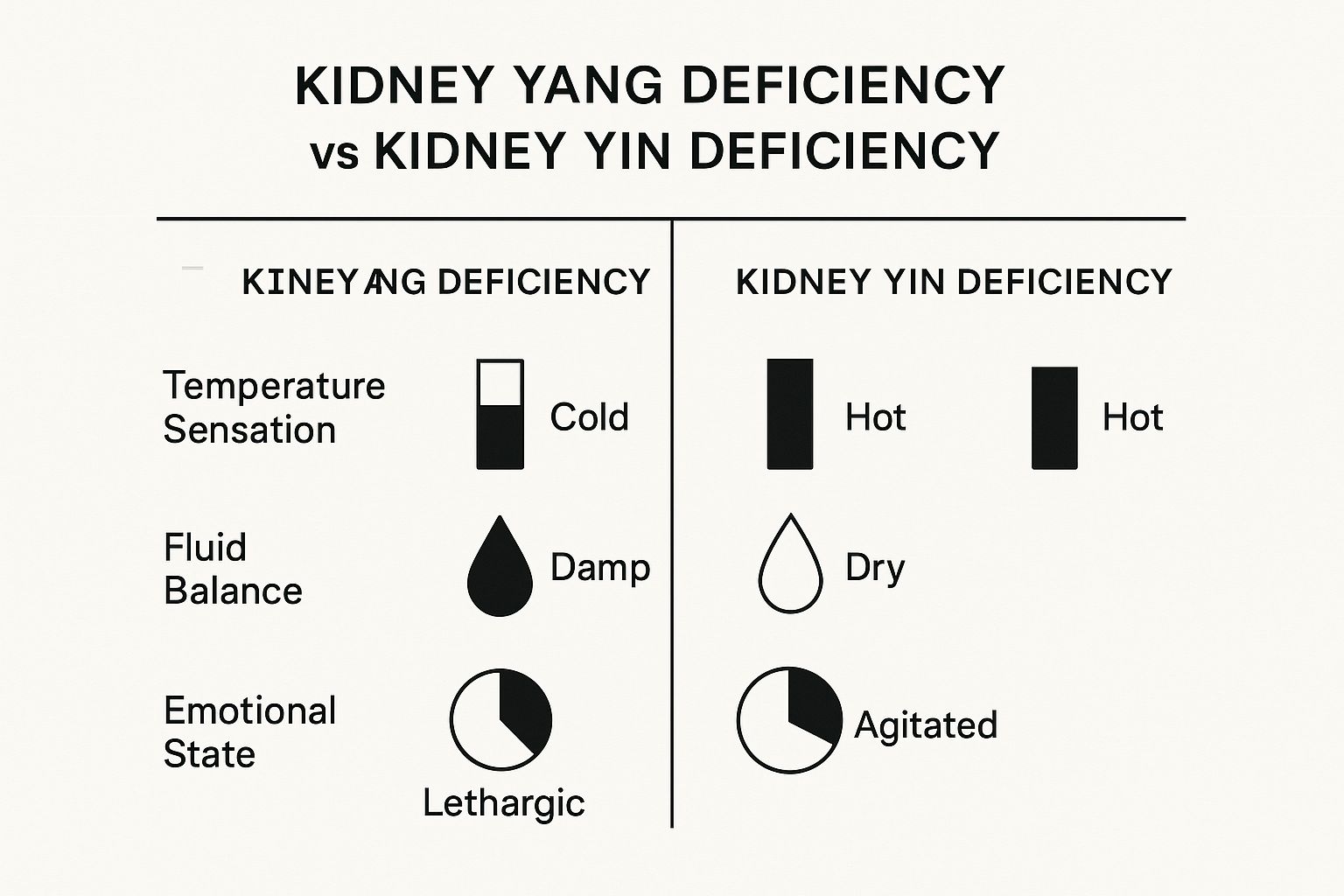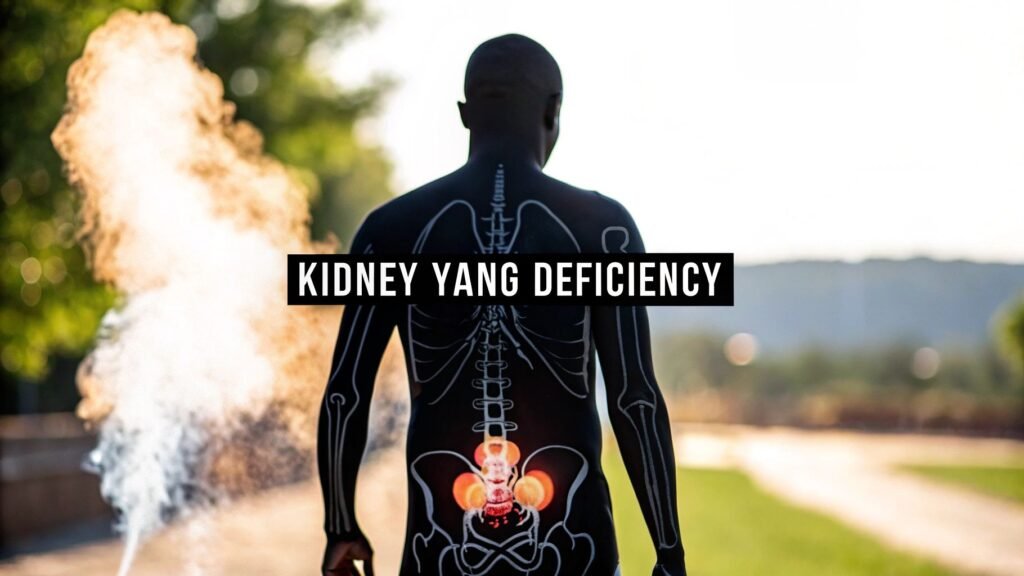Kidney Yang Deficiency is a common pattern we see in Traditional Chinese Medicine (TCM) that points to a decline in the body's core warming and energizing functions. When we talk about kidney yang deficiency symptoms, we're often looking at a collection of signs like a persistent feeling of cold, deep-seated fatigue, a weak or sore lower back, and problems with fluid metabolism.
It’s less of a "disease" in the Western sense and more like your body's internal furnace is running on low.
What Is Kidney Yang Deficiency

Before we can really unpack Kidney Yang Deficiency, we need to understand what the "Kidneys" mean in TCM. This concept goes far beyond the two bean-shaped organs that filter blood. In Chinese medicine, the Kidneys are considered the powerhouse of the entire body, the place where we store our most fundamental life force, known as Jing or essence.
Think of it like this: your body has a pilot light that provides the constant warmth and energy needed for every single process to function, from digestion to thinking. That pilot light is Kidney Yang. It’s the dynamic, warming force that keeps your hands and feet warm, fuels your metabolism, supports healthy reproductive function, and gives you the get-up-and-go to tackle your day.
When this fire starts to burn low, the body’s functions naturally begin to slow down and cool off. This isn't usually a sudden event; it's often a gradual decline that comes with aging, a long-term illness, or an exhausting lifestyle.
The Foundation of Your Vitality
In TCM, the Kidneys are often called "the root of life." They are in charge of our entire life cycle—governing birth, growth, development, and reproduction. A strong and vibrant Kidney Yang ensures all these processes run smoothly. It provides the essential warmth that every other organ system needs to do its job properly.
When that warmth is insufficient, a whole cascade of symptoms can emerge, impacting everything from your energy levels to your fluid balance. These aren't just random, isolated issues; they are interconnected signs that all point back to this one root imbalance.
This is a classical concept that has been central to TCM for over 2,000 years. Modern surveys of patients with chronic ailments in China even show that approximately 35-45% exhibit signs consistent with a Kidney Yang deficiency pattern.
Kidney Yang Deficiency represents a functional decline in the body's core energetic warmth. It's like trying to run a complex machine in a freezing-cold environment—everything becomes sluggish, inefficient, and slow to respond.
Grasping this core concept is the first step toward recognizing its specific signs in yourself or others. A skilled practitioner can get a remarkably clear picture of your body’s energetic state through different diagnostic methods. To get a feel for one of the most important techniques, you can read more about Chinese medicine pulse diagnosis.
Kidney Yang Deficiency At a Glance
For a quick summary, this table breaks down the essential aspects of Kidney Yang Deficiency.
| Concept | Description |
|---|---|
| Core Function | Provides warmth, energy, and motivation for all bodily processes. |
| Common Signs | Feeling cold, fatigue, lower back pain, frequent urination. |
| TCM Analogy | The body's "internal furnace" or "pilot light." |
| Primary Role | Governs aging, reproduction, and foundational vitality. |
This at-a-glance view helps connect the dots between the TCM concept and its real-world manifestations in the body.
The Telltale Signs of Internal Cold

When the body's pilot light—the Kidney Yang—burns too low, it just can't generate enough warmth to keep the entire system running efficiently. This creates what we call a state of "internal cold" in TCM, which gives rise to some of the most classic kidney yang deficiency symptoms. We're not talking about fleeting chills here, but a persistent, deep-seated cold that feels like it’s coming from your very core.
One of the most immediate giveaways is a profound aversion to cold. This is far more than just disliking winter. It’s that feeling of being chilled to the bone, where you find yourself reaching for a sweater in a room where everyone else feels perfectly fine. You're the person who needs a blanket on the couch in July or has to avoid the frozen food aisle at all costs.
This pervasive cold often settles in specific parts of the body, giving us clues as to where the Yang energy is struggling the most.
Cold Hands and Feet
Perhaps the most common complaint is perpetually icy hands and feet. Think of it this way: when the central furnace is weak, it simply doesn't have the power to push warmth all the way out to the body's distant suburbs—the fingers and toes. They're last on the supply line, so they're the first to feel the shortage.
This isn't the kind of temporary coldness you get from making a snowball. It's a chronic state where your hands and feet remain cold to the touch, even when you're bundled up in a warm room. People with this sign often tell me they have to wear socks to bed year-round just to fall asleep.
A Deep Chill in the Lower Back and Knees
In the landscape of TCM, the lower back is considered the "mansion of the Kidneys." It's the physical headquarters for this entire organ system. So, it makes perfect sense that a deficiency in Kidney Yang often shows up as a distinct feeling of cold, weakness, or soreness right in the lumbar area and knees.
This isn't a surface-level chill; it’s a deep, internal cold that you just can't seem to shake. It's often accompanied by a dull ache that feels noticeably better with a little warmth, like a heating pad or a hot bath. That desire for external heat is a dead giveaway that the body is lacking its own internal source.
The physical sensations of Kidney Yang Deficiency—like needing extra layers or feeling a constant chill in your lower back—are your body's way of signaling that its core energetic furnace needs support.
Learning to recognize these signs of internal cold is the first step. They are clear messages that the body’s foundational warmth is faltering. Each symptom tells a piece of the same story: the pilot light is low, and its gentle heat isn't reaching every corner of the body as it should.
How It Affects Fluid Balance in Your Body
Beyond that feeling of deep, internal cold, one of the most revealing kidney yang deficiency symptoms is a major disruption to your body's fluid management system. In the world of Chinese medicine, Kidney Yang is the pilot light that warms, transforms, and moves water throughout your entire system. When this vital energy flickers and weakens, fluids simply aren't processed the way they should be.
I often explain it to my patients like this: think of a low fire under a pot of water. A strong, roaring fire (healthy Yang) easily turns water into steam, which can then circulate properly as usable energy and moisture. But when that fire is just a weak flicker, the water just sits there, eventually pooling and overflowing.
This simple analogy gets to the heart of why someone with Kidney Yang deficiency can experience seemingly opposite symptoms when it comes to fluids.
The Paradox of Frequent Urination and Swelling
A classic tell-tale sign is the need for frequent urination, especially of clear, almost colorless urine. This often gets much worse at night, leading to a condition known as nocturia, where you're waking up multiple times to use the restroom. The weakened "fire" of the Kidney Yang just doesn't have the power to hold and concentrate fluids anymore, so they pass right through the body far too quickly.
At the very same time, because your body isn't effectively transforming and transporting these fluids, they begin to accumulate in your tissues. This is what leads to that characteristic puffiness or edema, which we most often see in the lower body—think ankles, feet, and lower legs. This isn't just any swelling; it's often the kind that "pits," meaning if you press a finger into the skin, an indentation stays there for a few moments.
This fluid buildup creates a heavy, waterlogged sensation and is a huge contributor to the overall feeling of fatigue. This accumulation of unprocessed fluid is a key aspect of what we call Dampness in Chinese medicine, which is an almost inevitable consequence of a weakened Yang.
The body's inability to properly "steam" and circulate fluids leads to a dual problem: fluids are lost too easily through urination while simultaneously pooling in the body's tissues as edema and puffiness.
This connection isn't just an ancient concept, either. Modern research has started to notice the significant overlap between Kidney Yang Deficiency patterns and chronic kidney disease (CKD). In fact, some studies show that up to 40% of CKD patients exhibit symptoms that align perfectly with this TCM pattern, including edema and frequent urination. Interestingly, researchers also found higher rates in colder climates, which perfectly supports the TCM theory that external cold can invade and further weaken the body's essential Yang energy. You can explore more about the link between these conditions in this study.
How It Drains Your Energy and Vitality

While feeling cold and dealing with fluid retention are hallmark signs, a weakened Kidney Yang strikes at the very heart of your vitality. This isn't just being tired after a long week; it's a deep, bone-weary exhaustion that never seems to lift. Imagine your body's central power source slowly draining, turning every simple task into a monumental effort.
This profound energy drain isn't just physical. It often casts a shadow over your mental and emotional well-being, leading to a general lack of drive, enthusiasm, and get-up-and-go. When your body's foundational fire dwindles, it's hard to muster the internal spark needed for joy and ambition.
The Link to Reproductive Health
In the world of Chinese Medicine, the Kidneys are considered the foundation of our reproductive power and constitutional strength. It’s no surprise, then, that some of the most prominent kidney yang deficiency symptoms show up in this system for both men and women. The warming, activating energy of Yang is absolutely critical for healthy reproductive function.
When this energy falls short, one of the first things people often notice is a drop in their libido. It’s as if the body, recognizing its low power reserves, smartly decides to conserve energy by powering down functions that aren't essential for immediate survival.
This pattern can show up in a few different ways:
- For Women: This might look like a decreased sex drive, challenges with conception, or menstrual irregularities like a late cycle with pale blood.
- For Men: Common signs include low libido, impotence, erectile dysfunction, or issues with sperm motility or count.
These symptoms really underscore how an imbalance in one part of the body sends ripples through the entire system. Stepping outside of TCM for a moment, looking into modern concepts like understanding cellular health and lasting vitality can provide a complementary perspective on how to maintain your body’s core energy.
The triad of low energy, diminished libido, and reproductive challenges is a classic textbook presentation of Kidney Yang Deficiency. It perfectly illustrates how the body’s core “fire” fuels not just our daily stamina but also our most fundamental life-creating capacity.
While TCM offers a unique diagnostic framework, modern health data shows a related pattern. The global increase in chronic kidney disease tied to metabolic problems has led to a doubling of disability-adjusted life years between 1990 and 2019—a staggering rise of over 120%. Many of these patients report symptoms like fatigue and cold intolerance, which strongly echo the classic TCM pattern.
Kidney Yang vs. Kidney Yin Deficiency
To really get a handle on Kidney Yang Deficiency, it’s incredibly helpful to look at its opposite number: Kidney Yin Deficiency. In the world of Traditional Chinese Medicine (TCM), Yin and Yang aren't separate things; they're two sides of the same coin, constantly in a delicate dance. When one of them becomes depleted, the other can seem overactive, which gives rise to a very specific set of symptoms.
A great way to think about this is to picture your body's energy system as a car engine.
Kidney Yang is the engine's power source—the gasoline and the spark that ignites it. It's the active, fiery energy that generates warmth, drives movement, and gives you that get-up-and-go.
Kidney Yin, on the other hand, is the engine's coolant and oil. It’s the fluid, calming substance that keeps the system moist, nourished, and prevents it from overheating and burning out under stress.
A Kidney Yang Deficiency is like trying to run that car on an empty tank. The engine is cold, sluggish, and just doesn't have the power to get going. In contrast, a Kidney Yin Deficiency is like running the engine without any coolant. It quickly starts to overheat, run erratically, and risks seizing up from all the excess heat and friction.
Spotting the Key Differences
As you might guess, the symptoms for these two patterns are polar opposites. Kidney Yang Deficiency is fundamentally a pattern of cold, slowness, and dampness. This is what leads to those classic signs like cold hands and feet, deep fatigue, and fluid retention.
Kidney Yin Deficiency, however, is all about heat, dryness, and agitation.
Someone with a dominant Yin deficiency often feels hot, particularly in the evenings or during the night. They're more likely to experience:
- Night sweats or a distinct sensation of heat in their palms, the soles of their feet, and chest (a classic sign known as “five-palm heat”).
- A persistent dry mouth, throat, and skin.
- Feelings of restlessness, anxiety, or difficulty staying asleep.
The core distinction is simple: Yang deficiency is an issue of insufficient fire, leading to cold and stagnation. Yin deficiency is a problem of insufficient water, leading to heat and dryness.
To help you see the differences more clearly, here’s a side-by-side comparison of the common signs.
Kidney Yang Deficiency vs. Kidney Yin Deficiency
| Symptom Category | Kidney Yang Deficiency (Cold & Damp) | Kidney Yin Deficiency (Heat & Dry) |
|---|---|---|
| Temperature | Feeling of cold, cold limbs, aversion to cold | Feeling of heat, night sweats, five-palm heat |
| Energy & Mood | Lethargy, fatigue, apathy, low motivation | Restlessness, anxiety, insomnia, mental agitation |
| Fluids & Moisture | Edema (swelling), clear & copious urine, loose stools | Dry mouth, dry throat, thirst, constipation, dry skin |
| Libido & Sexual Health | Low libido, impotence, infertility | May have high libido but with dryness or premature issues |
| Pain & Discomfort | Dull, aching lower back and knees that feels better with heat | Aching in lower back and knees with a feeling of heat |
| Appearance | Pale or bright-white complexion | Flushed cheeks (malar flush), red tongue with little coating |
This table clearly lays out how the same system—the Kidneys—can express disharmony in completely opposite ways depending on whether the "fire" or the "water" is lacking.
This infographic also provides a great visual summary of the core sensations, fluid balance, and even the emotional states tied to each pattern.

As you can see, the daily experience of a person with Yang deficiency (cold, damp, and tired) is the direct inverse of someone struggling with Yin deficiency (hot, dry, and agitated).
Figuring out which of these patterns more closely reflects what you're feeling is a crucial first step. It gives a practitioner the clarity they need to develop the most effective strategy for restoring your body's natural harmony.
Causes and How Balance Is Restored
So, what leads to this kind of internal chill? Kidney Yang Deficiency rarely happens overnight. It's more of a slow burn—or rather, a slow fizzle—where your body's foundational "pilot light" gradually dims over time. A few usual suspects are often at play.
The most natural one is simply aging. As we get older, our deep constitutional energy, known as Jing, naturally declines, and with it, the Yang fire it supports. Long-term, chronic illness is another major drain, as the body uses up its precious energy reserves just trying to cope.
And, of course, there's our modern lifestyle. Relentless overwork, emotional burnout, and chronic stress are like a constant draft blowing on your internal furnace, slowly but surely extinguishing the flames.
Your diet can also be a surprising culprit. Consistently eating cold or raw foods—think iced drinks, salads, and smoothies year-round—can directly chill your digestive system and force your body to expend its precious Yang energy just to warm things up.
Rekindling Your Internal Fire
Once a practitioner recognizes the classic kidney yang deficiency symptoms, the treatment goal becomes crystal clear: we need to warm and strengthen the Kidney Yang. The entire strategy revolves around gently stoking those internal embers until they glow brightly again. This isn't a one-size-fits-all fix; it's a personalized approach using a few key tools.
A licensed practitioner will draw from a toolkit designed to bring warmth and vitality back to your system:
- Acupuncture: By selecting specific points along the body’s meridians, we can direct warmth back to the Kidneys and stimulate the body's own Yang energy.
- Moxibustion: This is a truly classic technique for this pattern. It involves safely burning the herb mugwort over acupuncture points to send a deep, penetrating heat into the body that directly nourishes Yang.
- Herbal Medicine: We often prescribe carefully constructed formulas with warming herbs like cinnamon bark, prepared aconite, and deer antler. These ingredients work from the inside out to rebuild the body's core fire. To see how this works, you can explore some of the best herbs for kidney health and their properties.
The core principle of treatment is to add fuel back to the fire. By combining therapies that introduce warmth and nourish the body's energy, we can effectively address the root cause of the cold, fatigue, and fluid issues.
Beyond the clinic, what you eat is paramount. We'll often recommend shifting your diet to include more cooked, warming foods. Things like ginger, garlic, lamb, and warming spices act as supportive fuel, helping your body maintain its internal heat.
Answering Your Questions
When you start learning about concepts like Kidney Yang Deficiency, it's natural for a few practical questions to pop up. Let's walk through some of the most common ones I hear in my practice to connect these traditional ideas to real-world health.
Can Kidney Yang Deficiency Affect My Weight?
Yes, it's one of the most common connections people notice. Think of your Kidney Yang as the pilot light for your body's metabolism. When that flame is low, your whole system runs cold and slow.
This means your body isn't burning through calories as efficiently as it should, often leading to gradual weight gain that feels impossible to shed, no matter how much you diet or exercise. This is often made worse by the water retention (edema) that comes with the pattern, adding extra "water weight" and a general sense of puffiness.
Is This the Same as Having Kidney Disease?
This is a really important distinction to make. In TCM, Kidney Yang Deficiency is a functional diagnosis, describing an imbalance in your body's energy and warmth. It's not a physical or structural problem with the kidney organs themselves, which is what Western medicine tests for.
You can have a textbook case of Kidney Yang Deficiency and still have perfectly normal kidney function according to blood tests and ultrasounds. We're looking at the body through two very different—though often complementary—lenses.
How Long Does It Take to Restore Kidney Yang?
Rebuilding your body’s core energy is a marathon, not a sprint. The timeline really depends on your unique situation and a few key factors:
- How long the imbalance has existed: A pattern that has been developing for years, or even decades, will naturally take longer to rebalance than a more recent one.
- Your lifestyle and diet: Actively choosing warming foods, avoiding cold drinks, and managing stress can make a huge difference and speed up your recovery.
- The severity of your symptoms: A deep-seated deficiency requires more time and consistency to rebuild from the ground up.
Most people start to feel some initial relief within a few weeks of consistent treatment, but building a deep, lasting reserve of Yang energy can often take several months of dedicated effort.
At Eric Tsai Acupuncture and Herbs, my focus is on pinpointing the root cause of your symptoms and crafting a personal plan to guide your body back to its natural state of balance. If the signs of Kidney Yang Deficiency resonate with you, I invite you to schedule a consultation and start your journey back to warmth and vitality. You can learn more at my website: https://drerictsai.com.

